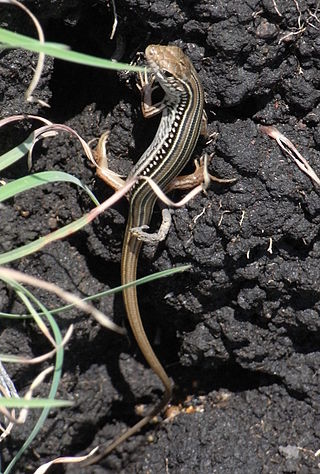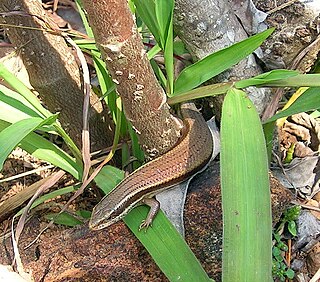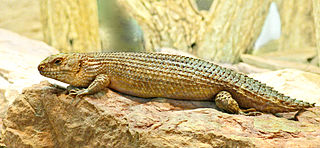
Skinks are lizards belonging to the family Scincidae, a family in the infraorder Scincomorpha. With more than 1,500 described species across 100 different taxonomic genera, the family Scincidae is one of the most diverse families of lizards. Skinks are characterized by their smaller legs in comparison to typical lizards and are found in different habitats except arctic and subarctic regions.

Ctenotus is a genus of skinks, lizards in the family Scincidae. The genus is endemic to Australia. The genus Ctenotus belongs to a clade in the Sphenomorphus group which contains such genera as Anomalopus and the close relatives Eulamprus and Gnypetoscincus.

Egernia is a genus of skinks that occurs in Australia. These skinks are ecologically diverse omnivores that inhabit a wide range of habitats. However, in the loose delimitation the genus is not monophyletic but an evolutionary grade, as has long been suspected due to its lack of characteristic apomorphies.

The pink-tongued skink is a species of lizard in the family Scincidae. It is endemic to Australia, where it is also called commonly the pink-tongued lizard. As suggested by these common names, its distinguishing characteristic is a pink tongue as opposed to the blue tongue of lizards of the closely related genus Tiliqua.

Blue-tongued skinks comprise the Australasian genus Tiliqua, which contains some of the largest members of the skink family (Scincidae). They are commonly called blue-tongued lizards or simply blue-tongues or blueys in Australia or panana in Indonesia. As suggested by these common names, a prominent characteristic of the genus is a large blue tongue that can be bared as bluff-warning to potential enemies. The type of predator/threat that is near will determine the intensity of colour present in the tongue. The tongue can also deform itself and produce a thick mucus in order to catch prey. They are relatively shy in comparison with other lizards, and also significantly slower due to their shorter legs.

Cunningham's spiny-tailed skink, also known commonly as Cunningham's skink, is a species of large skink, a lizard in the family Scincidae. The species is native to southeastern Australia.

Scincella reevesii is a species of skink, a lizard in the family Scincidae. The species is endemic to Asia.
The great desert skink, also known as Kintore's egernia and by various names including tjakura in various Aboriginal Australian languages, is a species of skink, a lizard in the family Scincidae. The species is endemic to the western half of Australia. It is a burrowing lizard and extremely social.

The Adelaide pygmy blue-tongue skink or pygmy bluetongue is a species of skink, a lizard in the family Scincidae. The species was previously thought to be extinct and only rediscovered in 1992. Known locations of the species extend from Kapunda in the Light River valley, about 77 kilometres (48 mi) north east of Adelaide, northwards to Peterborough, about 254 kilometres (158 mi) north of Adelaide.

Lygosominae is the largest subfamily of skinks in the family Scincidae. The subfamily can be divided into a number of genus groups. If the rarely used taxonomic rank of infrafamily is employed, the genus groups would be designated as such, but such a move would require a formal description according to the ICZN standards.

The fire skink, also known commonly as Fernand's skink, the Togo fire skink, and the true fire skink, is a fairly large skink, a species of lizard in the family Scincidae. The species is known for its bright and vivid coloration. Native to tropical forests in West and Central Africa, the fire skink lives fifteen to twenty years. This species is a diurnal lizard that burrows and hides. It is relatively shy and reclusive, but may become tame in captivity.
Thwaites's skink, also known commonly as the fourtoe snakeskink, is a species of skink, a lizard in the family Scincidae. The species is endemic to the island of Sri Lanka.

The Centralian blue-tongued skink or Centralian blue-tongue is a species of skink, occurring predominantly in the far north-west corner of New South Wales, Australia. It is one of six species belonging to the genus Tiliqua; the blue-tongued skinks and the shinglebacks. This species of reptile classifies as a lizard.

Egernia stokesii is a gregarious species of lizard of the Scincidae family. This diurnal species is endemic to Australia, and is also known as the Gidgee skink, spiny-tailed skink, Stokes's skink and Stokes's egernia. The species forms stable, long-term social aggregations, much like the social groups seen in mammalian and avian species. This characteristic is rarely found in the Squamata order, but is widespread within the Australian subfamily of Egerniinae skinks. Populations of E. stokesii are widely distributed, but fragmented, and occur in semi-arid environments. There are three recognised subspecies. The conservation status for the species is listed as least concern, however, one subspecies is listed as endangered.
The saltbush slender bluetongue is a species of lizard in the family Scincidae. The species is endemic to the arid interior of eastern Australia. Although its conservation status is of least concern, it has been listed as endangered in New South Wales. The slender saltbush bluetongue has been recorded in Sturt National Park in New South Wales but extends into northeast South Australia and south-west Queensland.
Egernia douglasi, also known commonly as the Kimberley crevice-skink, is a species of lizard in the family Scincidae. The species is endemic to Australia.

The desert egernia, unadorned desert-skink or desert skink is a species of skink, a lizard in the family Scincidae. The desert egernia is endemic to the continent of Australia, and is widespread, with populations recorded in all mainland states and territories except the Australian Capital Territory. The desert egernia is found in dry, desert areas with deep, uncompacted sandy/loamy soils and little significant vegetation cover.
Slater's desert skink, also known commonly as the Centralian Floodplains desert-skink, Slater's egernia, and Slater's skink, is a species of lizard in the family Scincidae. The species is endemic to Australia. There are two recognized subspecies.
















